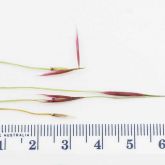Chilean needle grass

Chilean needle grass glumes encasing the seed - a distinctive purple-red colour
© Queensland Government

Chilean needle grass infestation
© Queensland Government

Chilean needle grass plant form
© Queensland Government

Chilean needle grass plant seed along roadside
© Queensland Government

Chilean needle grass seeds plant
© Queensland Government

Chilean needle grass seeds
© Queensland Government
Native to Chile, Ecuador, Bolivia, Argentina, Uruguay and southern Brazil, Chilean needle grass is a perennial tussock grass.
One of Australia's worst weeds, it is a major pest in Victoria and New South Wales and is also found in South Australia and Tasmania. Southern Queensland has small infestations. Chilean needle grass infests pastures and native grasslands and reduces natural biodiversity by replacing native species.
You must manage the impacts of Chilean needle grass on your land.
You must not give away, sell or release Chilean needle grass into the environment.
Scientific name
Description
- Perennial tussock grass that grows in dense clumps, either with other grass species or alone.
- Foliage is erect, up to 1m tall.
- Leaves are 1–5mm wide, flat, strongly ribbed on upper surface.
- Leaf edges are rough to touch.
- Before flowering, difficult to differentiate from other tussock grasses.
- When flowering, visible flowers develop on long stalks above foliage.
- Flower heads are 60mm long, with windblown appearance and pale-green awn (tail) at end of seed.
- New flowers have dark red colour produced by bracts that encase seeds.
- Awns are curved or bent.
- Seeds have reddish corona between body and awn.
- Seeds are 8–10mm long, pale brown when mature.
- Dry flower heads are straw-coloured, can remain on plant after seed has dropped.
Habitat
- Found along roadsides and drainage lines and in pastures.
Distribution
- Visit Weeds Australia and click on the distribution tab to access the distribution map.
Life cycle
- Germination occurs mainly in autumn and spring.
- Reproduces from seed.
- In addition to normal seeds, hidden seeds are produced in nodes and base of flowering stems.
- Produces more than 20,000 seeds per square metre.
- Seed bank persists for many years.
- Seedlings have high survival rate and can flower and produce seeds in their first season.
Affected animals
- Sheep
Impacts
Environmental
- Reduces natural biodiversity by replacing native species.
Economic
- Heavy infestations displace desirable pasture species.
- Decreases productivity of pastures by up to 50%.
- Long, sharp seeds injure animals, downgrading lamb and sheep meat, wool, skins and hides.
How it is spread
- Spread by seeds sticking to clothing, livestock, vehicles and farm machinery, in contaminated seeds or fodder, and by slashers and earth-moving equipment.
- Also spread by floodwater moving seed downstream and over flood plains.
- Little ability to spread by wind.
Prevention
Control
Physical control
- Manually remove small infestations before they flower and set seed.
Plant management
- Infestation with this weed is symptomatic of prolonged grazing, which tends to eliminate palatable plant species and allow unpalatable species to multiply without restriction. Sustainable land management practices result in systems that are naturally more resilient to weed infestation.
- Feed stock in controlled areas to minimise risk of seed spread and limit area requiring control.
Herbicide control
- Flupropanate is a residual, non-selective herbicide and little is known of its impact on other grassland and pasture plant species in southern Queensland.
- It is recommended that landholders perform trials with this herbicide before using widely, and plan for reseeding or other activities to ensure ground cover is maintained.
Read the Chilean needle grass fact sheet (PDF, 1MB) for herbicide control and application rates.
Biological control
- No known biological control agents.
Legal requirements
- Chilean needle grass is a category 3 restricted invasive plant under the Biosecurity Act 2014.
- It must not be given away, sold, or released into the environment. Penalties may apply.
- You must take all reasonable and practical measures to minimise the biosecurity risks associated with dealing with Chilean needle grass under your control. This is called a general biosecurity obligation (GBO).
- At a local level, each local government agency must have a biosecurity plan that covers invasive plants in its area. This plan may include actions to be taken on Chilean needle grass. Some of these actions may be required under local laws. Contact your local council for more information.